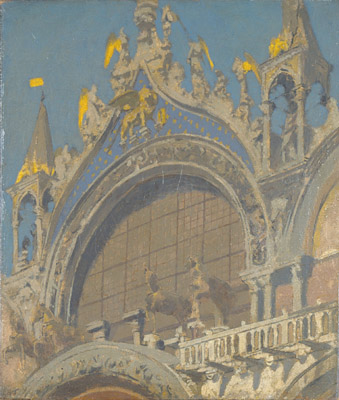“The effect of St Mark’s with the late afternoon sun shining upon it is too delicious for words,” wrote the painter Frank Richards, in an issue of The Studio, published in 1894; “it is simply marvellous – the upper part and domes shine out, as it were, beset with diamonds and mosaics, all glittering in the unpolluted sunlight from a Venetian sky; the lower part of the Cathedral and Piazza being in shadow of the most lovely lilac hue, dotted here and there with the many-tinted costumes of the natives, and occasionally with the white dresses of nurses.”
A year or two later, Walter Richard Sickert painted a dazzling series of pictures of St Mark’s that might have been inspired by that very encomium. In rapidly worked skeins and meshes of paint, dabbed on to the canvas with a loaded brush, Sickert conjured up its Byzantine mosaics and the play of light on its hump-backed, onion-domed bulk. In version after version, he caught the different moods of different times of day. He painted it against the flat and green-tinged sky of a misty afternoon, on one of those days when the air takes on the same milky colours as the lagoon. He painted it against a crepuscular sky of aching crimson and against a red sky at night. Closing in on a fragment of the whole, he painted the famous horses of St Mark’s. They are prancing equine ghosts, beneath a teetering parade of stone angels, against the clear blue infinity of noon.
“Sickert in Venice”, at the Dulwich Picture Gallery, is a small exhibition with a tight focus. The most adventurous English painter of his time visited the city regularly between 1894 and 1904. Robert Upstone, who has curated the exhibition and written its excellent catalogue, argues...
A year or two later, Walter Richard Sickert painted a dazzling series of pictures of St Mark’s that might have been inspired by that very encomium. In rapidly worked skeins and meshes of paint, dabbed on to the canvas with a loaded brush, Sickert conjured up its Byzantine mosaics and the play of light on its hump-backed, onion-domed bulk. In version after version, he caught the different moods of different times of day. He painted it against the flat and green-tinged sky of a misty afternoon, on one of those days when the air takes on the same milky colours as the lagoon. He painted it against a crepuscular sky of aching crimson and against a red sky at night. Closing in on a fragment of the whole, he painted the famous horses of St Mark’s. They are prancing equine ghosts, beneath a teetering parade of stone angels, against the clear blue infinity of noon.
“Sickert in Venice”, at the Dulwich Picture Gallery, is a small exhibition with a tight focus. The most adventurous English painter of his time visited the city regularly between 1894 and 1904. Robert Upstone, who has curated the exhibition and written its excellent catalogue, argues...


